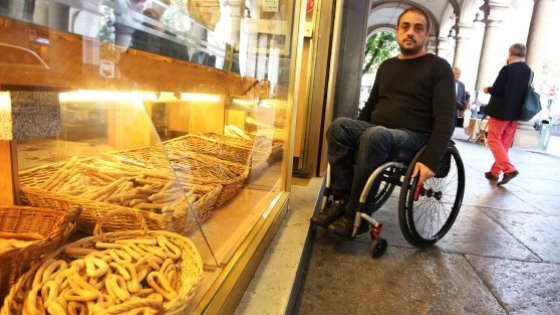Public places have to be accessible to all regardless their mobility capacity. The City Administration regulated the matter for new buildings as well as existing ones. The latter faced a variety of unforeseen problems that resulted into a 10% compliance rate in 15 months since the law passed. In the common understanding, this means a public effort not hitting the target, a cracked relationship between the City Administration and private businesses and ultimately disadvantaged people still vulnerable.
The story begins in 2015 with the City of Milan to pass the Building Regulation article 77 that required all bars, shops, restaurants and craft activities bordering the road, to provide easy access to people with limited mobility or disabilities (the National Institute of Statistic in 2007 assessed 13.189 people with mobility disabilities in Milan). This normative action was the instrument that City of Milan deployed to overcome architectural barriers and provide universal free access to public places by 2017.

In November 2016, 12 month after the law passed the City of Milan assessed only 2.000 businesses compliant over 18.000. An article on la Repubblica, the second most read Italian newspaper, by the 5 January 2017, published these data and opened a public discussion on the subject.
Lisa Noja (delegate of the Major for accessibility policies) said: We have to make sure that very quickly all businesses comply. This year we want to get to the full application of a rule of civilization and to do that you cannot only use repressive strategies.
It was a beginning of a twist in the Municipal strategy and the start of a speculation about the most effective way to enforce a regulation. The new thinking included working with trade associations, like Confcommercio, as well as promoting campaigns to engage business holders.
Cristina Tajani (City Councillor for labour policies, businesses, trade and human resources) said: places that show attention to the disabled are also easily accessible to children, parents with strollers and the elderly. This does not mean that they will not be submitted to controls, but we want help the business understand that the adjustment should not only be seen as an obligation. It is also a business opportunity.
This is when OpenCare approach came handy. Local staff including WeMake was involved and started talking to as many people as possible, to understand what was not working and tentatively get it streight.
Listening it was vital to start from the pieces of the City Administration that were involved from the beginning like the Major Cabinet, the Urbanistic Department, the Public Soil Occupation Office and lately Urban Economy and Work department. We have understood that the building legislation was conceived in a department and the implementing regulation was written in a different one (and of course published through another one). That gave a lot of room to officers for interpretations and tightening the instructions for businesses to prevent opportunistic behaviors.
Including as the collaboration with the trade association got closed we’ve understood more of the problems that businesses are facing to comply with the regulation, such as: high costs, complex red tape, lack of understanding of the most suitable solution and existing solutions too standardized. Since red tape is partially due to complex implementing regulations and the unclear communication follows, we started facilitating a mutual dialogue between pieces of public administration, businesses and associations. Regarding costs and production related problems, we can take it into the arena of manufacturing 4.0 by including also designers, makers, social innovators, businesses and utilizers.
Going where innovation beats we have started organizing an experimentation called Open Rampe (Rampe means Ramps/Slides) in a limited area of the city that has everything it takes. The Quartiere Isola in fact has a functioning District for Urban Commerce, a civic center devoted to urban regeneration, art and crafts workshops (ADA stecca), active businesses and a long tradition of civic participation. Our idea is to engage business individually and through a public event by 11th April. Involving them into co-design sessions pivoting around their necessities may generate unexpected outcomes.
Dealing with collective intelligence is what we have just started doing by sharing this story here. Any input from the community could be brought into our experimentation and add value to it. It would be interesting to study this collaboration as it happens and share it.
This is where we stand now and the next steps are:
Co-designing / mobilizing resources of course we will not predefine outputs, but rather keep the sessions open to any outcomes.
Prototyping policies by monitoring and evaluating this experimentation.
We are aware that talking about “enforcing” a policy collaboratively may sounds an oxymoron. Since article 77 of the building regulation fits in the EU and the National legal frameworks, it is certainly a top down process. Nevertheless, the Open care approach might help policy makers, (non)compliant businesses, users and citizens to achieve simpler, cheaper and faster solutions.
It would be interesting to know who else has been involved in a similar process and managed it collaboratively. Or not.
